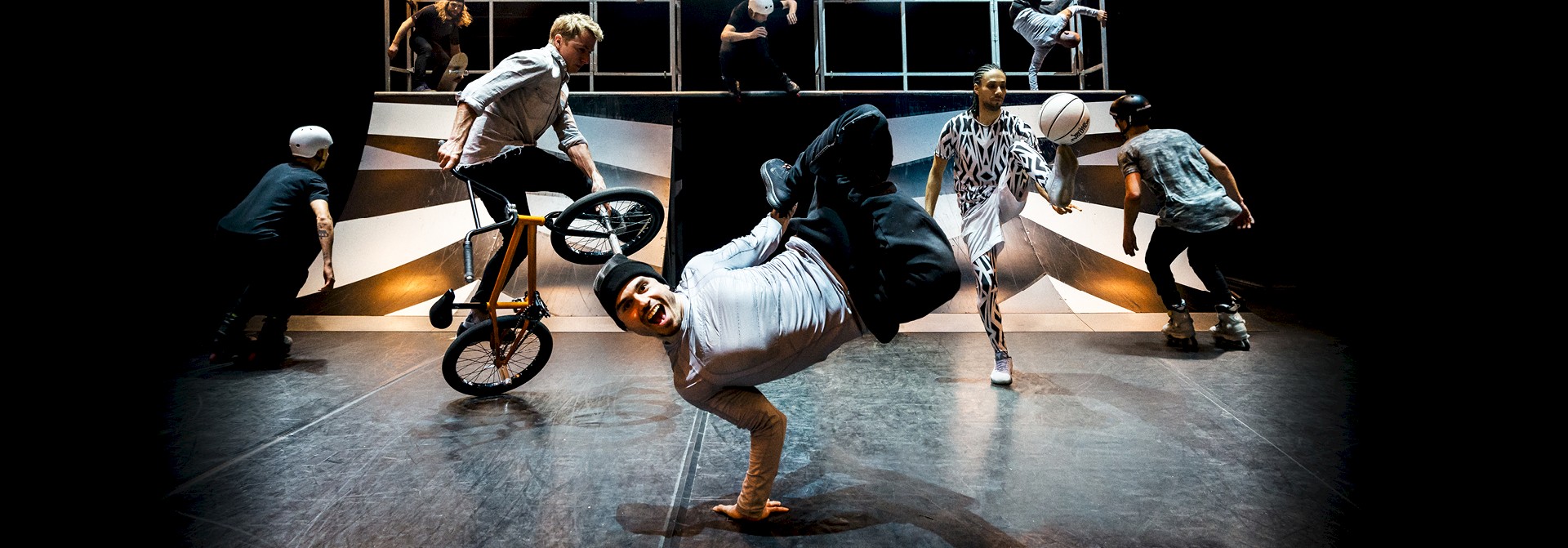"I think it's a mixture between not understanding the world and not feeling welcomed or wanted": Iggy Malmborg's SATAN is a reimagined campfire story about fitting in
10.7.2024
 Original photos: Rolf Arnold | Composition: Kari Söderqvist
Original photos: Rolf Arnold | Composition: Kari Söderqvist
This theatrical piece is supposedly a true story. SATAN is a playfully autobiographical solo piece by Swedish actor-director Iggy Malmborg. Flirting with dark temptations and an artist’s coming-of-age story, this is a tale of a hero who tries to become a villain but fails. SATAN is co-produced by Schauspiel Leipzig, Frascati Theater & BIT Teatergarasjen. After touring around Europe, Malmborg’s journey leads him to Tampere. SATAN is performed in English, subtitled in Finnish and it might include a little bit of Swedish.
”SATAN is part of a longer cycle of works where I focus on the basic elements of the theatrical situation, one at the time. This show deals with illusion, what its function is and how different illusions are being produced and how they ultimately affect us by creating reality. I am going back to the very basic form of oral storytelling and making a piece where I concentrate on sitting down and telling a story without immediate illusionist tools like light changes or sound design.”
Paradoxical processes – illusion through authentic material
Malmborg begins by pondering on the matter, that even true life stories told with the aid of language structures is, in the end, nothing but a theatrical trope. He goes on by pointing out how so-called reality-tv has nearly taken over the entire broadcast. It’s quite striking, since even dramas ’based on a true story’ have almost outnumbered the ones that are pure fiction. Malmborg describes that SATAN is a comment on that.
”I guess we’ve all noticed how the use of authentic material on stage, in difference to fictionalized drama, is something that is becoming more and more common. I think it is interesting to note how that is a trend that seems to coincide with the experimental art field and in commercial media.”
Malmborg wanted to explore his observations on the matter. He created a piece of theatrical illusion by working with authentic material. When using the term illusion, one often thinks of a dichotomy between the term and reality, asking 'is this real or fake ?'. In this piece Malmborg wants to question that view and rather think of illusion not as something opposing our reality, but rather as a compliment to it.
”The question SATAN is trying to raise is not whether something is fake, but how illusion is put in play. Even if we appreciate something as an illusion, it is hard to deny its acute material realness. I could use an utterly peculiar Swedish Christmas tradition, where a grown up, often the father, dresses up as Santa Claus. He speaks with a deeper voice, and he hands gifts to the kids of the family. The father knows very well that he is not Santa Claus and does not find any pleasure in the play (besides some uncanny exceptions), but he still performs it for the enjoyment of the children. The kids on the other hand, very well know it is not Santa, but their dressed up father. Still, they play along in order not to embarrass him. It is not unusual that everyone involved performs their part, because without the illusion of a beard and a red hat, there would be no Christmas and without Christmas no holiday. Illusions produce reality.”
Are we capable of fulfilling what is expected from us?
The feeling of being different and wanting what others have acts as a catalyst in SATAN. The main character wants or tries to become something similar to others, thus advancing the story. Malmborg tells about his haunting feelings of being a stranger. To him, it’s a mixture between not understanding the world and not feeling welcomed or wanted.
”But sometimes, when seeing myself from a distance, a scenario even more nightmarish than being different appears: I wake up, brush my teeth, log into social media platforms and in the worst case I even go to the gym. There’s nothing strange or different about me, I am merely obeying. I’m exactly like everyone else, doing exactly what is expected. I end up saying what is expected of me. I’m just a kind of parrot, nothing more.”
Malmborg then brings the topic of illusions back on the table. He believes the system of thoughts and experiences, being based on some level of narrative and deception, shapes our impressions and puts us in motion. Psychoanalysis suggests that illusions are fundamental to the structure of reality. Social categories, like race or gender, are examples of somatic illusions, yet they of course exist in the world with fatal consequences. Most of the time we all act (or try to act) accordingly, fulfilling those illusory categories, like language or gender. We perform in relation to them and grow into (or out of) them, with all that includes.
”Yet I must say that the piece does not address gender in an outspoken way, rather in how it is being played out in the story told, how gender is performed. It is approached in a rather materialistic way. Without spoiling too much, one could say that there’s three or maybe four types of masculinity presented in SATAN and they all have different material results. They are being rewarded in different monetary and social ways; given access to different privileges if you want.”
Malmborg brings the topic of expectations and masculinity to a close by mentioning, that he would rather spend a night in a forest cabin with the knowledge of a bear nearby rather than having a man nearby. Without a doubt, most likely everyone has bad experiences with men, and the storyline in SATAN is not too different: this is a tale of a hero who tries to become a villain but fails.
Embrace your inner baddie and come find out what this tale is all about. SATAN is performed at Tampere University Main Building’s Teatterimonttu (Kalevantie 4) on Tuesday 6.8. at 19.00 o’clock and on Wednesday 7.8. at 13.00 o’clock. Buy your tickets now from Lippu.fi-webstore.
The article is based on an interview with Iggy Malmborg.
Text by Kari Söderqvist


